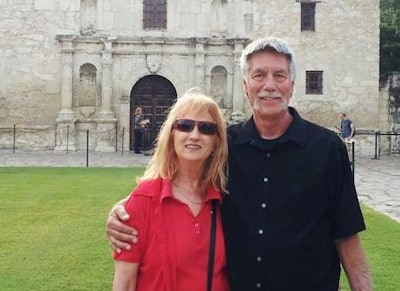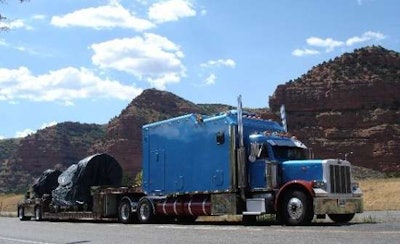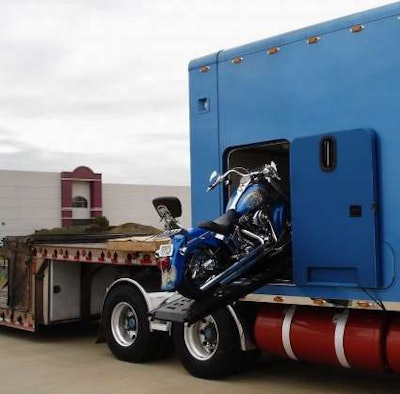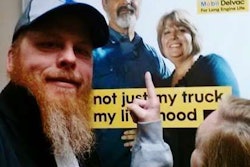Note: This story originally ran in August 2013.
Gregg Blair is one of our friends and a reader on the George and Wendy Show Facebook page. He sent us a letter the other day, and it was possibly one of the most fascinating stories I’ve ever read. I love to hear the true veterans of the industry talk about old times — it’s a real treat to get one on the CB who wants to talk. It’s even better to have a six-million-mile veteran write a story for you. Thanks, Gregg. Your story is priceless, and I’m humbled you let me share it. —Wendy Parker
 Gregg Blair retired in Ft. Worth, Texas, where he enjoys his days happily tinkering around the house, camping, and spending time with his wife.
Gregg Blair retired in Ft. Worth, Texas, where he enjoys his days happily tinkering around the house, camping, and spending time with his wife.I bought my first Peterbilt in 1975 at age 24 and trucked full-time until a year and a half ago, when I couldn’t pass the DOT physical due to several heart conditions and had a cardiac defibrillator implanted.
You might be interested to know that we didn’t have cell phones, computers, satellite radio, or tubeless tires for trucks. In their infancy were engine brakes, radar, and air-ride suspensions. The length limit east of the Mississippi was 55 feet, and nationwide speed limit was 55 mph. The gross weight limit was 73,280 lbs. in most states, 32K on tandems and12K on the steer. Trailer lengths were mostly 38-40 feet.
I started out hauling dry freight in a box. Six months later, I switched to flatbedding with International Transport out of Rochester, Minn. We called it the “Crayola Box,” because we had to paint our truck green and yellow to match our primary customer, John Deere. Ten years later, IT sold their authority to Schneider and became Schneider Specialized. In 1985, I leased on with Southern Pride Trucking in San Diego, where I lived, and hauled jet engines for the next 27 years until I was forced to retire.

“Six million miles. When Dad died in 1976, I wouldn’t have known except I blew out a tire on company trailer and called in for a P.O. number.” –Gregg Blair
Before deregulation of trucking, we had authority to haul specific commodities to and from specific locations. Authority looked more like a phone book than a document. Occasionally we would “interface” with another company to use their authority, and we would have to detour through the interface point.
If a trucker ran east, they pretty much had to have a cabover, and 350 hp was a pretty big engine, although there were some monsters available, like the KTAs. There were very few cops and a third of the traffic there is now out in the Western boonies. The interstate system wasn’t finished and you had to have a license to talk on a CB radio. There were no private showers in truck stops and not many women truckers. Diesel cost about 25 cents per gallon, depending on what state you were in. The log book only got checked about once a year, and it wasn’t any big deal. No long-form medical — we only carried the medical card, and it was pretty hard for cops to check if it was legitimate. I usually filled out my own medical card when it expired. Elizabeth Dole brought in the DOT as you know it today.
 “HOME ON THE ROAD” — That’s how Gregg Blair describes the 1999 Peterbilt he last owned, powered by a 600-hp C16 Caterpilla with 18 speed autoshift and 3:55 rears. The full-length double frame was outfitted with tanks that could carry 500 gallons fuel. The sleeper was built by ICT and weighs in at 200 inches on an air-ride bunk mate. “I put about 1.75 million miles on that truck,” says Blair. Inside the sleeper were featured a kitchen, shower and toilet, washer/dryer, 42-inch flatscreen with surround sound and tracking satellite TV dish.
“HOME ON THE ROAD” — That’s how Gregg Blair describes the 1999 Peterbilt he last owned, powered by a 600-hp C16 Caterpilla with 18 speed autoshift and 3:55 rears. The full-length double frame was outfitted with tanks that could carry 500 gallons fuel. The sleeper was built by ICT and weighs in at 200 inches on an air-ride bunk mate. “I put about 1.75 million miles on that truck,” says Blair. Inside the sleeper were featured a kitchen, shower and toilet, washer/dryer, 42-inch flatscreen with surround sound and tracking satellite TV dish.President Ronald Reagan appointed Elizabeth Dole to head the DOT around the time deregulation and, later, the CDL came into effect. It was certainly easier to haul more products, however the rate to haul them was open to competition. The competition became fierce, and truckers’ profit diminished. Survival depended on your ability to adapt. Prior to the CDL, it was very easy to get a license to drive a truck. In some states, a car license was adequate.
There was no multiviscosity oil, and combined with much lower compression ratios, this made it difficult to crank up in the winter. We had a manual compression release so we could wind it up before starting the engine. Wheels were two-piece, many on Dayton hubs. And there were only bias ply tires. You were doing good to get 100,000 miles out of a tire. If you ran a tire flat for more than a couple miles, you could kiss it goodbye.
 The rear 50-inch compartment on the ICT sleeper functioned as a garage with an electric motorcycle lift. “Keeps the bike clean like it is in the backseat of your car,” says Blair.
The rear 50-inch compartment on the ICT sleeper functioned as a garage with an electric motorcycle lift. “Keeps the bike clean like it is in the backseat of your car,” says Blair.Winters really were brutally colder in the 70s and 80s. I remember many times when the temperature was colder then -30 F. Once in Northern Alberta, I had a load of plate steel that couldn’t be unloaded because it was -50 F. They used a crane with tongs that bit into the steel, and told me they weren’t allowed to unload below -40 F because the tongs would slip off. But good news, the next day it warmed up to -40.
In the 90s many people sold their snowmobiles — the winters were so mild there wasn’t enough snow to ride. Temperatures were considerably warmer, too. In recent years, the big storms are coming back. Apparently, there’s a cycle.
We didn’t have clutch fans. The engine fan ran all the time. To keep the engine warm, we had shutters with a thermostat to open them called a “shutterstat.” Ether was used to fire up when it was cold. No ABS brakes. One of the first ABS systems was “121,” which could be affected by radio transmissions such as a big linear amplifier, occasionally leaving you without any brakes. 121 didn’t stay on the market very long, but I loved mine because you had great brakes when they were working.
Very few trucks had power steering. “Center point” steering was easy to steer but still not hydraulic assist. Air assist was early power steering.
Not all hubs were oil bath. Many were just packed in grease. No LED lights, only bulbs. Some air cleaners were oil bath, unlike today’s paper elements. Unburned diesel fuel is black smoke, and there was plenty of that coming out the stacks.
Three wasn’t much chrome available unless you had something chromed yourself. Stainless, too. Front bumpers were skinny, often a steel channel. Windshield wiper motors were pneumatic. The CB radio only had 23 channels, and they weren’t limited to 4 watts. We had “fire in the wire.”
We were only allowed 8 feet of width (96 inches), and big cities had wider lanes than they do now. Cities have had to squeeze in an extra lane. At 96 inches wide and another foot of lane and a third the traffic, it was much easier to navigate, not to mention the short wheelbases and short trailers.
America respected and loved truckers a lot more then. But what’s not to love. We had Sonny and Will.
There was a fairly widespread usage of amphetamines. Not for me, though. They would leave you absolutely exhausted. I preferred to focus on good sleep when you had time for it. I could cover a lot more ground.
Six million miles. When Dad died in 1976, I wouldn’t have known except I blew out a tire on company trailer and called in for a P.O. number.










